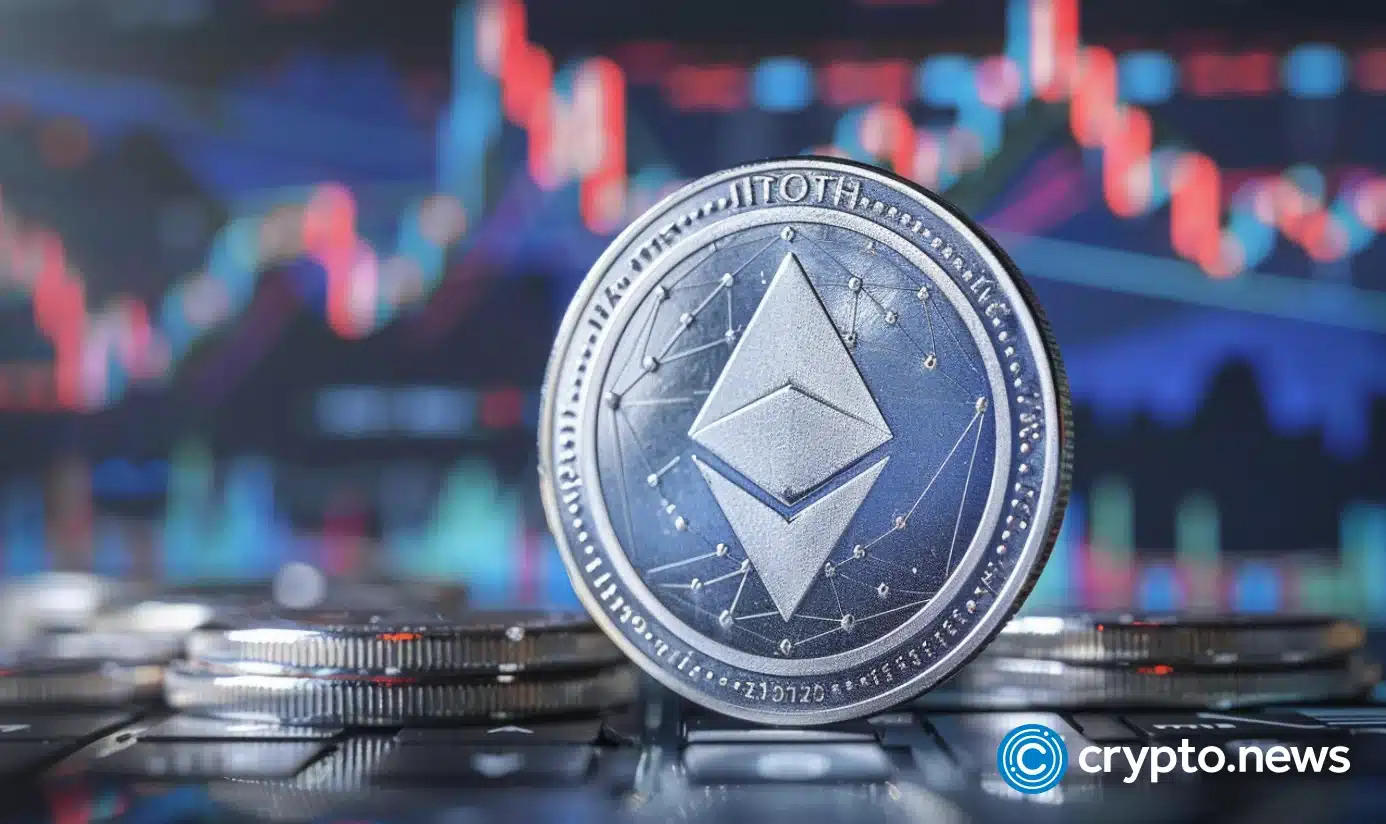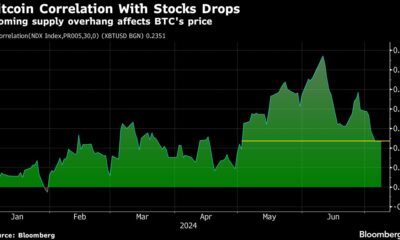Markets
Fineqia Research Analyst Discusses the Impact of Spot ETFs on Bitcoin Market Dynamics

Crypto.news recently spoke with Matteo Greco of Fineqia International to discuss the current state of the Bitcoin ETF market and what we can expect in the future.
Bitcoin has emerged as one of the best-performing assets of the last decade.
It has transcended its status as a lesser-known peer-to-peer payments system, catalyzing the creation of an entirely new asset class that now boasts a market capitalization of over $1 trillion.
With the approval of 11 Bitcoin ETFs in sight in January 2024, traditional investors now have an easier path to gaining exposure to the leading cryptocurrency.
These investment vehicles are reshaping the crypto sector, having attracted billions of dollars in market capital. In addition to legitimizing Bitcoin, these have also attracted substantial interest of institutional actors.
Another factor that could impact the Bitcoin ETF sector is the potential approval of spot ethereum ETFs. Analysts expect these to capture 20% of investment flows currently heading into spot Bitcoin ETFs, further adding to the intrigue.
With these developments in place, the market continues to be a dynamic and unpredictable arena. The future of Bitcoin ETFs, while promising, is being shaped by a myriad of factors, including regulatory developments and macroeconomic trends.
How could these influence the market dynamics of these investment vehicles? How could this impact the price of Bitcoin?
According to Greco, inflows into Bitcoin ETFs are significant, but they are not the only factor influencing the price of Bitcoin.
Why does the substantial inflow of capital into Bitcoin ETFs not correspond to an equivalent increase in the market price of Bitcoin?
There are several factors that can increase or decrease the price, including supply and demand, liquidity and leverage. It’s not as simple as a single factor correlation to price action. However, it is incorrect to say that the entry did not support positive price action. When BTC ETFs were approved on January 10, the price of BTC was around $46,000. Currently, BTC has been ranging between $65,000 and $70,000 for weeks, indicating a 40% to 50% price increase following approval. At the time of approval, the total market cap of BTC was around $900 billion and now, with BTC at $67,000, it is around $1.3 trillion. This represents a $400 billion increase in total market value, while BTC ETFs saw around $16 billion in net inflows. This means that BTC market cap growth was 25 times greater than the value of net inflows into BTC Spot ETFs. This demonstrates that the impact of the approval and commercialization of these products has been substantial, extending beyond the direct influx into these financial products. It helped sustain demand for the asset due to positive sentiment and medium-term expectations about Bitcoin and the digital asset space in general.
Could the possible approval of an Ethereum ETF significantly change the investment landscape for Bitcoin ETFs?
Bitcoin (BTC) and Ethereum (ETH) are fundamentally different assets with distinct intrinsic characteristics. Bitcoin uses a Proof of Work consensus mechanism, which relies on miners, while Ethereum, like most digital assets, employs Proof of Stake, which does not require computing power to confirm transactions. This mechanism allows ETH and many other digital assets to offer staking rewards to investors, similar to dividends in traditional finance. BTC, however, does not have integrated staking rewards and therefore has different characteristics and cannot be classified as a security. Given the different characteristics and use cases of these two main digital assets, I do not foresee outflows from BTC ETFs moving to ETH ETFs. Instead, I expect net inflows into ETH ETFs, as they represent a distinct asset that new investors, or those who have already invested in BTC ETFs, may also want to gain exposure to.
What impact could the introduction of an Ethereum ETF have on Bitcoin’s status as the leading cryptocurrency?
BTC was the most prominent cryptocurrency before ETFs were approved and will remain so after BTC and ETH ETFs are approved. If BTC loses its dominance, it will take considerable time for ETH to overtake BTC in market value. It will be interesting to watch traditional finance’s appetite for ETH as an asset. For comparison, BTC attracted around $16 billion in net inflows during Q1 and Q2, assuming fairly neutral flows for the remaining three weeks of Q2 for the sake of simplicity. ETH’s market capitalization is about a third of that of BTC, so proportionally it should attract about $5 billion in the six months post-launch to match BTC’s level. Higher entries would indicate more enthusiasm for ETH, and lower entries would suggest otherwise. Although it is challenging to make direct comparisons due to different market sentiments at the time of launch, this serves as a useful index for medium-term analysis.
Are traditional asset ETFs, such as gold, influencing Bitcoin market dynamics?
I would look at this from the opposite perspective. Traditional asset ETFs have been trading for a long time and the introduction of digital asset ETFs to the market represents increased competition. For example, the impact of BTC ETFs has been significantly stronger compared to the introduction of the first gold ETF in 2004. This indicates that investors have a defined appetite for digital assets, meaning that a portion of the allocation previously reserved exclusively for digital assets Traditional finance is now being driven towards digital asset ETFs.
As for the influence of BTC Spot ETFs on the market, these products undoubtedly reinforce BTC’s global recognition. With some of the most prominent traditional financial companies issuing and/or holding BTC, this leads to increased liquidity, greater security, and reduced spreads and commissions for investors and traders.
With the launch of ETFs, has Bitcoin generated enough institutional and retail interest to support its proposed role as a hedge against inflation?
I would not limit BTC to being classified solely as a hedge against inflation. Although BTC can serve as a hedge against inflation in the long term, it is not a safe hedge in the short term due to its high volatility. BTC has attracted strong institutional and retail interest for a variety of use cases, which highlights its versatility. Being fully decentralized with no CEO or board, investors can buy and trade BTC based on their preferred use case. Some people buy and hold BTC as a long-term investment or as a hedge against inflation. In countries with hyperinflation, people can use BTC as a hedge against short-term inflation. Others see it as a speculative investment, while some appreciate its decentralized nature and the idea of a currency not issued by central governments. It is incorrect to classify BTC into a single category. Bitcoin is an asset that can be used for a variety of purposes depending on individual circumstances and preferences, and its general adoption is increasing across the world.
Would you classify Bitcoin as a traditional investment hedge like gold?
At its current stage, I would classify BTC more as an investment, similar to stocks, due to its high volatility, rather than as a hedge against inflation, like gold or bonds during periods of high interest rates. In my opinion, an inflation hedge should primarily offer high stability and serve as an alternative to fiat currency – something stable and liquid that can be easily used to pay for services and quickly converted into cash in an emergency. BTC falls short in this regard because its value can fluctuate drastically depending on market conditions, meaning that converting BTC to fiat currency can result in significant losses if done at an unfavorable time.
What does this mean for Bitcoin?
While BTC can serve as a long-term inflation hedge and a means of increasing purchasing power, it cannot be set as an inflation hedge by default. For example, during the last bear market, BTC experienced its biggest declines, coinciding with spikes in inflation and increases in interest rates. On the other hand, BTC performed well again when central banks stopped raising interest rates as inflation eased. If BTC were a short-term inflation hedge, it would have behaved oppositely, rising during high inflation and macroeconomic uncertainty and slowing when inflation eased and interest rates stabilized. This pattern indicates that BTC is currently traded more as a risky asset, similar to stocks, than as a hedge against short-term inflation. As mentioned previously, the decentralized nature of BTC means that investors can define its role in the market. Currently, most investors perceive BTC as a risky asset and trade it accordingly.
Markets
Crypto Markets Rebound as Spot Bitcoin ETFs Attract Massive Inflows

This week saw $722 million worth of Bitcoin spot ETF inflows, including the largest daily inflow in a month.
Cryptocurrency markets rallied on Wednesday, driven by inflows into spot Bitcoin exchange-traded funds (ETFs).
The price of Bitcoin (BTC) is up 3% over the past 24 hours to last change hands at $65,200, according to CoinGecko. Ethereum (ETH) is up 2% and is trading at $3,471. Solana (SUN) and Polkadot (POINT) increased by 4%.
Bitcoin spot ETFs saw $422 million in daily inflows on Tuesday, the highest in the past 30 days, according to Far side data, . The all-time record for a single day was $1.05 billion on March 12.
Among Tuesday’s top contributors, BlackRock’s IBIT led with $260 million in inflows, followed by Fidelity’s FBTC with $61 million. This week has already seen more than $722 million in inflows.
Among the top 100 cryptocurrencies by market cap, Worldcoin (WLD) led with a 28% increase, followed by Helium (HNT) with 20% and Lido DAO (LDO) with 15%.
Worldcoin, a decentralized identity project led by OpenAI CEO Sam Altman, announced is extending the lockups for early investors and team members. This means that tokens will be gradually released through 2029, instead of the original 2027 plan. Token unlocks are generally seen as a negative because they increase supply and early investors can sell their tokens for profit.
Meanwhile, XRP, the token of the XRP Ledger network, jumped 8% after the CME and CF benchmarks introduced new indices and reference rates for XRP.
U.S. stocks faced a downturn on Wednesday. The S&P 500 fell 1%, while the Nasdaq Composite and Dow Jones Industrial Average both fell 2%.
Markets
Altcoins on the cusp of a major breakout – WLD, AR, and INJ prices could surge by 20% in the coming days

Crypto markets appear to have been taken over by the bulls as major tokens have surged above their crucial resistance zone. Bitcoin surged above $65,000 while Ethereum was above $3,500, and XRP, which had remained passive for quite some time, surged over 40% in the past few days to hit $0.6. The uptrend has been captured in most altcoins, with Worldcoin (WLD), Arweave (AR), and Injective (INJ) leading the rally. Here’s what to expect for these tokens in the coming days.
Worldcoin (WLD) Price Analysis
O Worldcoin Price has been trading inside a descending wedge since it marked a new ATH near $12 in the final days of Q1 2024. The recent price action helped the price break out of the upper resistance of the wedge, breaking above the crucial resistance zone between $2.21 and $2.39. Market sentiments have changed, but technicals suggest that the bulls may remain passive for a while, which could offer some room for a bearish pullback.
The price broke out of the wedge with a significant increase in volume, but the current volume suggests that the bulls have taken a step back. Meanwhile, the RSI is about to reach the upper boundary, which could attract bearish forces. Additionally, the DMI has undergone a bullish crossover, but the decline in the ADX suggests that the rally may remain consolidated above the gains. Therefore, the WLD price is expected to maintain a horizontal consolidation between $3 and $3.3 and trigger a fresh rally to $4.4 during the next bullish rally.
Arweave (AR) Price Analysis
Arweave formed a strong base around $25, which helped the rally trigger a recovery during the bearish attack. Mt. Gox and German terror forced the price to fall below $20. However, the recent price action has brought the altcoin within the bullish range and raised expectations of maintaining a decent uptrend for a few more days.
AR price has hit one of the major resistances around $30 to $31.5, which could act as a strong base once overcome. The buying volume is slowly increasing, which could keep the bullish hopes for the rally high. Moreover, the supertrend has just flashed a buy signal, indicating a clean reversal of the trend. Therefore, AR price seems primed to maintain a healthy uptrend and rally above $40. However, if the bulls maintain a similar trend, making new highs above $50 may not be a tedious task for the bulls.
Price Analysis of Injective (INJ)
Injective price has been showing sharp strength since the beginning of the year and hence, the recent turnaround is expected to revive a good uptrend going forward. The bears engulfed the rally to a large extent, but the recent price action suggests that the bulls have regained their dominance. Therefore, INJ price is expected to maintain a strong uptrend with a bearish interference on the way down.
INJ price has surged above the lower support zone and has registered consecutive bullish candles. Although the volume is below the required levels, the OBV is maintaining a sharp uptrend. Furthermore, the Ichimoku cloud lead span B is heading towards the lead span A and a healthy crossover indicates the start of a new uptrend. However, INJ price may be out of the bears’ reach once it secures the resistance zone between $30.77 and $32.12, which seems to be on the horizon.
Markets
Ethereum at $3.5K, Exchange Supply Hits 34-Month High

Ethereum (ETH) supply on exchanges has hit a 34-month high as the asset’s price surpassed the $3,500 mark.
ETH has risen 2.3% over the past 24 hours and is trading at $3,490 at the time of writing. The second-largest cryptocurrency — with a market cap of $419 billion — briefly touched an intraday high of $3,517 earlier today.
ETH Price, Whale Activity, RSI, and Exchange Supply – July 17 | Source: Santiment
Ethereum’s daily trading volume also increased by 7.6% to reach $19.8 billion.
According to data provided by Santiment, the supply of Ethereum on exchanges has reached $19.52 million ETH. This level was last seen in September 2021, when the asset was trading around the same price.
On the other hand, data from the market intelligence platform shows that the number of whale transactions has fallen by 12% in the last day — falling from 8,730 to 7,629 unique transactions per day.
The move shows that the supply of Ethereum on exchanges has been increasing with small deposits rather than large transactions from whales.
Additionally, the ETH Relative Strength Index (RSI) is currently hovering at the 60-mark, per Santiment. The indicator shows that Ethereum is slightly overbought at this price point, but it may not be in a critical position due to its large market cap.
One of the main drivers of Ethereum price increase is ETH spot expectations ETFs in the US Investment products are scheduled to start trading on July 23rd.
Markets
Bits + Beeps: How to Play the ‘Trump Trade’ in Cryptocurrencies After the Assassination Attempt

Also, how much will the Fed cut rates (and when)? What will be the inflows into ETH ETFs? And what is the near future for Bitcoin?
Posted on July 17, 2024 at 12:00 PM EST.
Listen to the episode at Apple Podcasts, Spotify, Capsules, Source, Podcast Addict, Pocket molds, Amazon Musicor on your favorite podcast platform.
In this episode of Bits + Bips, hosts James Seyffart, Alex Kruger and Joe McCann, joined by guest Jack Platts, dive into the market reaction to the recent assassination attempt on former President Donald Trump, analyzing how this event will influence the 2024 US presidential election and the cryptocurrency markets.
They also cover potential rate cuts: Could there be a cut in July? How big could the September rate cut be? Could the decision be influenced by the upcoming election?
They also give their predictions on what percentage of BTC ETF inflows the ETH ETFs will reach, and James talks about what he expects for Grayscale’s ETHE (hint: his outlook would be positive for ETH).
Finally, they delve into what’s next for Bitcoin as the German government runs out of BTC and Mt. Gox distributions begin. Just now?
Program Highlights:
- Whether Trump’s shooting decided the election and whether the event caused a “flight to safety”
- How election markets are becoming a place to watch election probabilities and whether cryptocurrencies “lean right”
- Whether rate cuts will occur in July or September and by how much they will cut: 25 bps or 50 bps
- How Joe sees the relationship between global liquidity cycles, rate cuts, and the potential rise of Bitcoin
- What are the new updates about Ethereum ETFs and their expected launch?
- Why Solana Hasn’t Performed Significantly Better Since Trump News
- What Market Breadth Indicates About the Current Market Rally and the Impact of Rates on Small Caps
- Everyone’s predictions on ETH ETF inflows and how much outflow we’ll see on Grayscale’s ETHE
- What’s Next for BTC After German Government Exits Bitcoin and Mt. Gox Giveaways Starting This Week
Hosts:
Guest:
- Jack PlattsCo-Founder and Managing Partner of Hypersphere Ventures
-

 DeFi12 months ago
DeFi12 months agoDeFi Technologies Appoints Andrew Forson to Board of Directors
-

 Fintech12 months ago
Fintech12 months agoUS Agencies Request Information on Bank-Fintech Dealings
-

 News1 year ago
News1 year agoBlock Investors Need More to Assess Crypto Unit’s Earnings Potential, Analysts Say — TradingView News
-

 DeFi12 months ago
DeFi12 months agoSwitchboard Revolutionizes DeFi with New Oracle Aggregator
-

 DeFi12 months ago
DeFi12 months agoIs Zypto Wallet a Reliable Choice for DeFi Users?
-

 News1 year ago
News1 year agoBitcoin and Technology Correlation Collapses Due to Excess Supply
-

 Fintech12 months ago
Fintech12 months agoWhat changes in financial regulation have impacted the development of financial technology?
-

 Fintech12 months ago
Fintech12 months agoScottish financial technology firm Aveni secures £11m to expand AI offering
-

 Fintech12 months ago
Fintech12 months agoScottish financial technology firm Aveni raises £11m to develop custom AI model for financial services
-

 News1 year ago
News1 year agoValueZone launches new tools to maximize earnings during the ongoing crypto summer
-

 Videos6 months ago
Videos6 months ago“Artificial intelligence is bringing us to a future that we may not survive” – Sco to Whitney Webb’s Waorting!
-

 DeFi1 year ago
DeFi1 year agoTON Network Surpasses $200M TVL, Boosted by Open League and DeFi Growth ⋆ ZyCrypto





